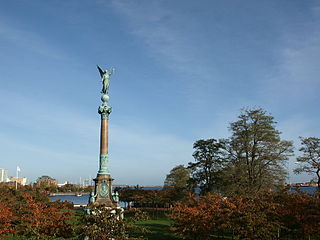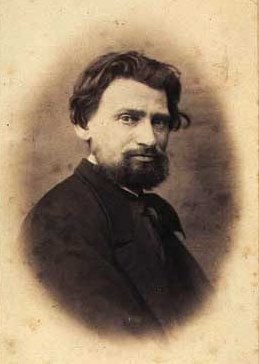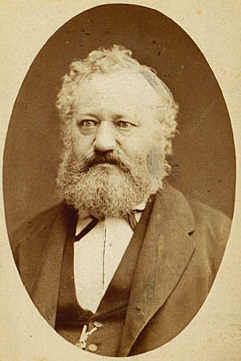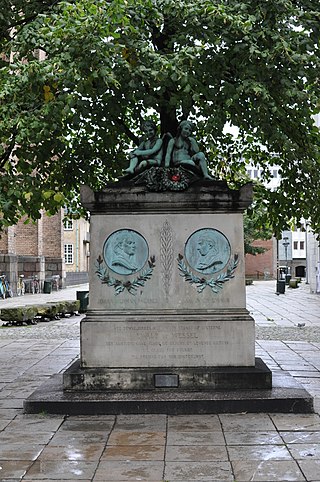
The Battle of Møn, also known as the Battle of Fehmarn, took place 31 May–1 June 1677, as part of the Scanian War. A smaller Swedish squadron under Admiral Erik Sjöblad attempted to sail from Gothenburg to join the main Swedish fleet in the Baltic Sea. It was intercepted by a superior Danish-Norwegian force under Niels Juel and decimated over the course of two days. The Swedes lost 8 ships and over 1,500 men dead, injured or captured, including Admiral Sjöblad himself, while the Danish losses were insignificant.

Niels Juel was a Danish admiral and naval hero. He served as supreme command of the Dano-Norwegian Navy during the late 17th century and oversaw development of the Danish-Norwegian Navy.

The Battle of Køge Bay was a naval battle between Denmark-Norway and Sweden that took place in the bay off of Køge 1–2 July 1677 during the Scanian War. The battle was a major success for Admiral Niels Juel and is regarded as the greatest naval victory in Danish naval history.

Nyboder is a historic row house district of former Naval barracks in Copenhagen, Denmark. It was planned and first built by Christian IV to accommodate a need for housing for the personnel of the rapidly growing Royal Danish Navy and their families during that time. While the area is still commonly associated with the name of its founder as one of his numerous building projects around Copenhagen, the Nyboder seen today was in fact, except for a single row of houses in Sankt Pauls Gade, built from 1757.

The Holmen Church is a Parish church in central Copenhagen in Denmark, on the street called Holmens Kanal. First built as an anchor forge in 1563, it was converted into a naval church by Christian IV. It is famous for having hosted the wedding between Margrethe II of Denmark, queen of Denmark between 1972 and 2024, and Prince Henrik in 1967. It is the burial site of such notabilities as naval heroes Niels Juel and Peter Tordenskjold, and composer Niels Wilhelm Gade, and contains artwork by, among others, Bertel Thorvaldsen and Karel van Mander.

The Ivar Huitfeldt Column is a monument at Langelinie in Copenhagen, Denmark, built to commemorate the death of Admiral Ivar Huitfeldt and his men from HDMS Dannebroge, which exploded and sank in the Battle of Køge Bat during the Great Northern War. The monument was constructed in 1886 to a design by Vilhelm Dahlerup. Ferdinand Edvard Ring was responsible for the statue of the Roman goddess of victory, Victoria, and for the reliefs, while Carl Brummer undertook the monument's architectural design.

Theobald Stein was a Danish sculptor. He was a professor at the Royal Danish Academy of Fine Arts and served as its director from 1883 to 1886.
Events from the year 1881 in Denmark.

Holmens Kanal is a short street in central Copenhagen. Part of the main thoroughfare of the city centre, it extends from Kongens Nytorv for one block to a junction with a statue of Niels Juel where it turns right towards Holmens Bro while the through traffic continues straight along Niels Juels Gade. The street was originally a canal, hence the name, but was filled in the 1860s. Today it is dominated by bank and government buildings.

The Edouard Suenson Memorial is located in front of Nyboder on Store Kongensgade in Copenhagen, Denmark. It commemorates Vice Admiral Edouard Suenson who commanded the Danish ships in the Battle of Heligoland 9 May 1864. The monument was designed by Theobald Stein and inaugurated on 9 May 1889. The bust was cast in Lauritz Rasmussen's bronze foundry.

Otto Frederik Theobald Evens was a Danish sculptor.

The statue of Peter Wessel Tordenskiold, created by Herman Wilhelm Bissen in the 1860s, is a bronze statue of the Norwegian-Danish naval hero Peter Wessel Tordenskiold located in the grounds of the Church of Holmen in Copenhagen, Denmark. Tordenskiold's tomb is located inside the church.

Lauritz Godtfred Rasmussen was a Danish zinc and bronze caster. He established a zinc and bronze foundry in his own name in Copenhagen in 1865 and was appointed royal court caster in 1883. Many Danish monuments from the second half of the 19th century come from his foundry. It was later taken over by his son Carl Rasmussen and remained in the family for several generations.

The Johannes Ewald and Johan Hermann Wessel Memorial is located next to the Round Tower and Trinitatis Church, just off Købmagergade, in central Copenhagen, Denmark. Johannes Ewald and Johan Herman Wessel were two of the leading Danish poets of the 18th century.

The Reunification Monument marks the main entrance to Fælled Park from Trianglen in the Østerbro district of Copenhagen, Denmark. It was created by the artist Axel Poulsen, in collaboration with the architect Holger Jacobsen, to commemorate the reunification of Sønderjylland with Denmark in 1920.
Henrik Span was a naval officer in the Dutch, Venetian and Danish services. He reached the rank of Admiral in the Royal Danish Navy in 1683 and headed the Royal Danish Naval Dockyard in Copenhagen from 1690. In 1692, he was granted Hørbygaard at Holbæk and raised to the peerage by Christian V of Denmark.

The Statue of Anders Sandøe Ørsted is located in Ørstedsparken in Copenhagen, Denmark. Anders Sandøe Ørsted was Denmark's leading jurist of the mid-19th century. He served as Prime Minister of Denmark in 1853–54.

The Statue of Asmus Jacob Carstens is a statue of German-Danish painter Asmus Jacob Carstens situated in the garden of the Ny Carlsberg Glyptotek, facing Niels Brocks Gade, in Copenhagen, Denmark. It was created by Theobald Stein in 1878–1879 and moved to its current location in 1894. It is complemented by a statue of Georg Zoëga facing Tietgensgade on the other side of the museum. The monument is flanked by two other bronze statues, Jules Dalou's Field Worker (1893) and Constantin Meunier's The Hammerman.

The statue of Ludvig Holberg by Theobald Stein, together with Herman Wilhelm Bissen's statue of Adam Oehlenschläger, flanks the main entrance to the Royal Danish Theatre on Kongens Nytorv in Copenhagen, Denmark. It was created by Stein in conjunction with the inauguration of Vilhelm Dahlerup's new theatre building in 1875. Bissen's statue of Oehlenschläger is from 1861 and was originally located on Sankt Annæ Plads.

Niels Juels Gade is a street in Indre By, Copenhagen, which runs from Holmens Kanal to Havnegade. The street is an extension of Christian IV's Bro to Christians Brygge and together with them forms part of Ring 2. Along the entire southern side of the street is Danmarks Nationalbank. On the northern side, there are a number of apartment buildings, which are primarily used for business. Furthermore, the Nigerien embassy is located in the street. The street is named after the naval hero Niels Juel (1629-1697).
























